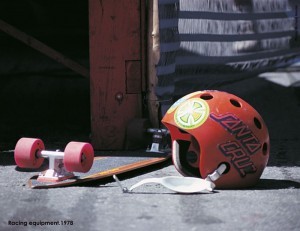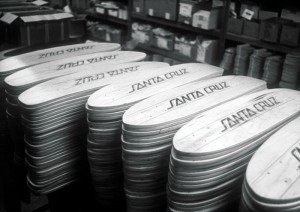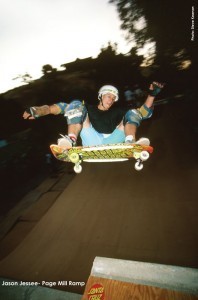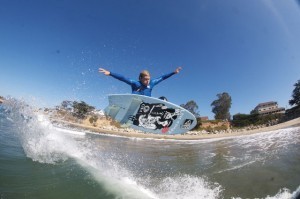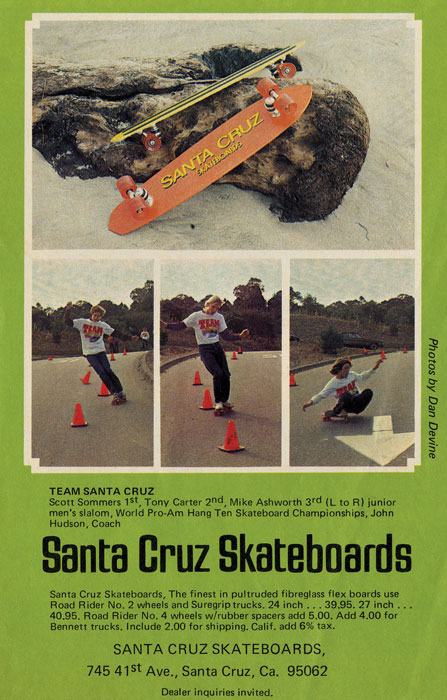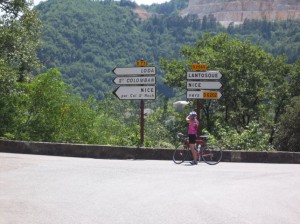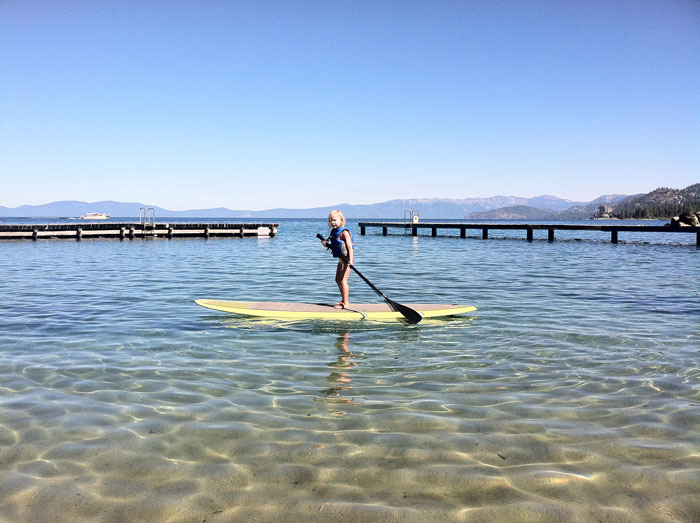- Tahoe’s Nevada Beach Tops the List of Hard-to-Book Campgrounds - 07/17/2024
- Cannabis Watershed Protection Program Cleans Up Illegal Grow Sites - 07/10/2024
- French Fire - 07/05/2024
Forty years of NHS
By Neil Pearlberg • Photos courtesy of NHS
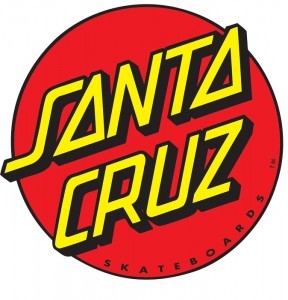
A design collaboration in 1978 between Jay Shuirman and artist Jim Phillips (father of Jimbo), the red dot Santa Cruz logo has become nearly ubiquitous.
Right before his tenth birthday, young Quintin fractured his wrist while trying a new trick on his skateboard. When his birthday arrived he was sporting a bright blue cast and proudly explaining to his friends that he was “attacked by a curb.” On that day, there was only one gift he wanted: a Santa Cruz Skateboard, adorned with the proper Jimbo Phillips graphics.
“He could barely get his smile through the front door as we left the Boardroom after picking out his present,” explained his mom Hilary, referring to the Santa Cruz Boardroom, a well-known skate shop on 41st avenue in Capitola. Hilary, who also happens to be the mayor of Santa Cruz, was left marveling at just how powerful her city’s namesake brand has become in the hearts and minds of her son and kids everywhere.
Celebrating its fortieth anniversary, the Santa Cruz brand (or NHS as the parent company is called) does indeed have a massive influence on youth culture. In some ways it’s not an exaggeration to say the city itself has been eclipsed by the brand. After forty years, the two are now almost inseparable. For while Santa Cruz is a city with problems just like any other city, it has a unique connection to a very compelling action sports brand, and this symbiotic relationship has become the envy of just about every coastal city in America—and just about every other action sports company—whether they admit it or not.
Of course, NHS can’t take sole credit for the high level of street-cred the city of Santa Cruz has in the eyes of the X games crowd—but the fact that the company can legitimately take any credit at all is remarkable.
Many hard working and talented people have contributed to this lofty success, but as anyone in the company will tell you, the story of NHS starts with one highly creative person: Rich Novak.
The History
In the sleepy beach town that was Santa Cruz in 1973, a trio of hardcore surfers named Rich Novak, Jay Shuirman and Doug Haut conspired to begin a surfboard company. With a vision of waltzing through their careers while surfing and selling boards, the men were focused on a laidback lifestyle.
The idea seemed good at the time, but Novak quickly found out the slim profit margins from shaping and selling surfboards were not going to sustain him. Inevitably, the partnership originally incorporated as NHS (an acronym using the first letter of their last names) was soon at a crossroads. The result was that one failing company blossomed into two separate companies, and both have stood the test of time.
Parting as friends, Rich Novak and Jay Shuirman split from Haut, seeing future fun and profitability in the up and coming sport of skateboarding, with the advantage of being able to sell their products all over the country.
Haut sold his shares of NHS and went on to establish his surfboard brand, Haut Surfboards, which to this day has shaped and sold over 30,000 surfboards. Both Haut and Novak were recently elected to their industry’s respective halls of fame, Novak for skateboarding and Haut for surfing.
Throughout the early ’70’s, Novak and Shuirman used the remnants of fiberglass from their surfboard manufacturing to make skateboard decks, all the while using the trucks and wheels supplied by a roller skate company. In 1974 the duo designed a high precision urethane wheel, the Road Rider, which proved to be a game changer. Over a million were sold by the end of 1975.
That same year in Los Angeles, at a small contest/trade show, a group of former surf industry leaders—each with their own skateboarding concepts—came together to form what would become an industry. Ron Bennett of Bennett Skateboard Trucks, Dave McIntrye of the Gordon Smith FibreFlex Skateboard line, Bill Bahne of Bahne Skateboards, Dave Dominy of Tracker Trucks, and Novak and Shuirman with their Road Riders, would meet each month at the San Clemente Inn to form an industry group, whose collaborations and inventions gave rise to bowl skating, vert skating, and generally speaking the sport of skateboarding as we know it today.
The Team
A proven recipe for success was carefully laid out and put into action by Novak as he assembled many of his early team riders currently on staff to join him in the adventure of building NHS.
President and CEO Bob Denike was a prominent Santa Cruz racer in the late 70‘s who first met Rich Novak at Winchester Skatepark in 1977. Novak was sporting long hair, dark glasses, and a shaggy beard as he handed young Bob a set of wheels to test ride. Bob’s mom immediately pulled him to safety, not trusting the “Grizzly Adams” looking character and ordering her boy never to speak to him again.
Tim Piumarta, who now oversees research and development for NHS, first recalls his introduction to both Novak and Shuirman in early 1975. John Hutson, who was pretty much the biggest name in skateboarding at the time, made the introduction.
“I work for these guys called ‘Shuck and Jive,’” Hutson told Piumarta. “They came up with these urethane wheels with precision ball bearings and I want you and your friends to check them out.”
Piumarta and his pals couldn’t believe their ears and good fortune as they were handed Road Rider wheels to skate their favorite bowl, The Pit, a drainage ditch in Rio Del Mar. “I didn’t know who Shuck and Jive were, but they sounded dodgy,” recalled Piumarta. “That afternoon the scruffy duo of Novak and Shuirman unfolded themselves out of a VW van and told me that I was their new ‘Chuck Yeager’ and my role was going to be that of a test pilot. It was like a scene from a Cheech and Chong movie.”
Novak instructed his newly formed Santa Cruz skateboard team of Hutson, Piumarta and friends that he had no interest in what worked well. He just wanted to know what didn’t work well. To this day, Novak credits this simple mandate with leading NHS to success.
That fateful day at the drainage ditch, where Piumarta shook the hand of the scruffy looking Novak, has turned into a 39-year career. “Pure dumb luck!” exclaimed Piumarta. “At the time I was barely making it through Cabrillo College, and with no skills other than riding a skateboard, I was damned near unemployable.”
Piumarta recalls why he was likely picked out of the group of skaters to test their products. “I was the only one wearing a helmet that day, and they both probably took one look at me and figured that if I went down testing their new stuff they weren’t likely to end up getting sued by my parents.”
Another important player in the history of NHS is Jeff Kendall, who grew up in Indianapolis. At the age of twelve he knew his future was somewhere in California, and he eventually moved here to skate. In 1988, the then twenty-one year old skate phenom turned pro to ride for NHS. By 1989 he was ranked third in the world, and was featured in such classic skate films as Wheels of Fire, and Streets on Fire. Novak saw more in Kendall than that just a kid who could skate, he saw a bright young dynamic mind, and out of his own pocket his employer paid for his professional education, having Jeff enroll in an ongoing executive development and management training program.
Kendall eventually became team manager for Santa Cruz Skateboards, senior marketing director at NHS, and in 2007 was promoted to Vice President.
Board Sports
In the early 1990‘s, at the beginning of the first Gulf War, the sale of skateboards and skate paraphernalia slowed to a crawl. Novak saw a possible savior for his company when snowboarding gained traction with the board sports crowd, and Santa Cruz Snowboards was soon up and running.
In 1997 Rich Novak and NHS came full circle and returned to the sport of surfing, with what he calls the “third leg of a three-legged barstool.” Having suffered through the cyclical stages of skateboarding and snowboarding, he figured that if one sport was failing, his company could always stay alive through the success of his two other products.
“Surround yourself with good people, design and build quality skateboards, snowboards, surfboards and bicycles, and combine them all with innovative marketing—that is how you become a hall of fame company,” said Terry Campion, owner of the Santa Cruz Boardroom. His inventory is stocked with well over 70% of products from NHS. “Novak assembled a small army of people who have worked for him for decades, a true sign of integrity,” said Campion. “He just stood on his horse and would point his sword in whatever direction, leading his team through thick and thin.”
Travel anywhere in the world, and somewhere on your journey you are going to come across the logo of Santa Cruz Skateboards, the infamous “red dot” adorned with the distinctive slanted typeface, in which the A’s in Santa Cruz are closed triangles. A design collaboration in 1978 between Jay Shuirman and artist Jim Phillips (father of Jimbo), the red dot Santa Cruz logo has become nearly ubiquitous.
In fact, the Santa Cruz brand has reached far beyond the world of skateboarding, to the point where parts of the world recognize the name Santa Cruz to be a brand rather than a coastal city in northern California. As mentioned, the city is sometimes eclipsed by the brand.
Credit must be given to the father and son team of Jim and Jimbo Phillips for creating the look of the brand over the years, and adding greatly to its mystique. In the same way it is fair to say there could be no Marvel Comics without artist Stan Lee, one cannot imagine NHS without Jim and Jimbo.
Recently I sat down with Novak in his Santa Cruz office and asked, “What would you do if NHS went out of business?” “I’d say it’s been fun,” said Novak roaring with laughter. “From the beginning the whole point of NHS was just to have fun.”
Novak was also quick to point out the cyclical nature of the action sports industry, which has been less than fun. Having faced both tragedy and triumph, he navigated his company through not just the pendulum of economic swings, but much closer to his heart, the tragic loss of his friend and partner Jay Shuirman to leukemia in October 1979.
Looking back on the last 40 years, I asked Novak which decades he liked the most. The answer was seemingly on the tip of his tongue. “No doubt the 70s and 80s. The 70s because it was completely raw, there were no rules, and it was like the Wild West,” recalled Novak with a wry smile. “In the 80’s we were making money and still having a great deal of fun, but rules were starting to creep into place.”
Today Novak says that unfortunately most of his time is spent dealing with those rules and the associated bureaucracy, lawyers, and accountants.
Though he has come a long way from that scruffy surfer who founded NHS, his focus will always be on the customers who are inspired by Santa Cruz products.
“Just last week I was discussing the set up of a skateboard with an eight year old kid. In the next room $600-an-hour lawyers were waiting for me to finish, but I didn’t care. At the time it seemed a lot more fun, and important, to be talking to a loyal customer.”


